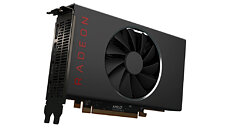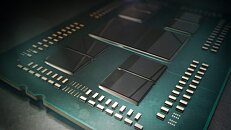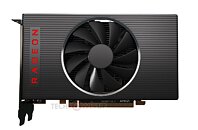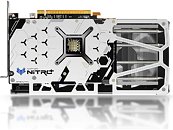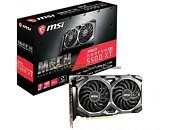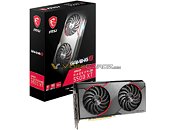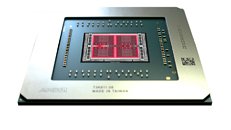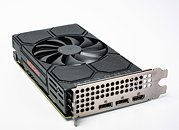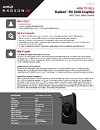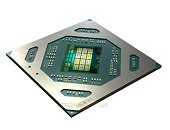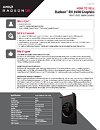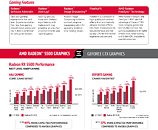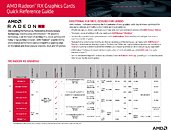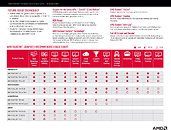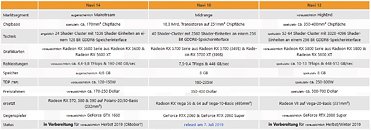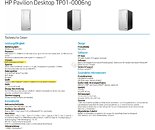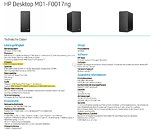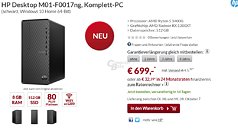Apr 10th, 2025 16:43 EDT
change timezone
Latest GPU Drivers
New Forum Posts
- 9070XT or 7900XT or 7900XTX (182)
- Steam Deck Owners Clubhouse (500)
- Good bluetooth controller with Android support (0)
- RX 9000 series GPU Owners Club (280)
- What are you playing? (23360)
- issue with restart after changing throttlestop settings (7)
- New posts added to last post (automatic post merging) (27)
- SAMSUNG A52s 5G // SM-A528B/DS - Delayed Security updates / seems 3 month cycle / no updates around october 2025. (0)
- Your GPU history? (370)
- Bios RX 570 (6)
Popular Reviews
- The Last Of Us Part 2 Performance Benchmark Review - 30 GPUs Compared
- ASRock Z890 Taichi OCF Review
- MCHOSE L7 Pro Review
- Sapphire Radeon RX 9070 XT Pulse Review
- Zotac GeForce RTX 5070 Ti Amp Extreme Review
- Sapphire Radeon RX 9070 XT Nitro+ Review - Beating NVIDIA
- PowerColor Radeon RX 9070 Hellhound Review
- Upcoming Hardware Launches 2025 (Updated Apr 2025)
- ASUS GeForce RTX 5080 Astral OC Review
- Acer Predator GM9000 2 TB Review
Controversial News Posts
- NVIDIA GeForce RTX 5060 Ti 16 GB SKU Likely Launching at $499, According to Supply Chain Leak (175)
- MSI Doesn't Plan Radeon RX 9000 Series GPUs, Skips AMD RDNA 4 Generation Entirely (146)
- Microsoft Introduces Copilot for Gaming (124)
- AMD Radeon RX 9070 XT Reportedly Outperforms RTX 5080 Through Undervolting (119)
- NVIDIA Reportedly Prepares GeForce RTX 5060 and RTX 5060 Ti Unveil Tomorrow (115)
- NVIDIA Sends MSRP Numbers to Partners: GeForce RTX 5060 Ti 8 GB at $379, RTX 5060 Ti 16 GB at $429 (103)
- Nintendo Confirms That Switch 2 Joy-Cons Will Not Utilize Hall Effect Stick Technology (102)
- Over 200,000 Sold Radeon RX 9070 and RX 9070 XT GPUs? AMD Says No Number was Given (100)
News Posts matching #Navi 14
Return to Keyword Browsing
AMD Rolls Out Radeon RX 5300: 1408 SP, 3GB GDDR6
AMD sneaked out the Radeon RX 5300 desktop discrete graphics card. At this point it's unclear if the card is an OEM exclusive, or if a retail channel launch is imminent. The RX 5300 desktop features an identical core-configuration to the RX 5300M mobile GPU that's been out since late-2019. The desktop RX 5300 surfaced on the Geekbench database in May 2020.
Based on the 7 nm "Navi 14" silicon, the RX 5300 is endowed with the same 1,408 stream processor count as the RX 5500 XT, but the memory amount and bus width has been cut down by 25%. It hence has 3 GB of GDDR6 memory across a 96-bit wide memory interface, which at 14 Gbps puts out 168 GB/s of memory bandwidth. The GPU ticks at 1448 MHz "game" clocks, and 1645 MHz boost. The typical board power of the RX 5300 is rated at 100 W, which means it requires at least a 6-pin PCIe power input and cannot make do with slot-only power. There's no word on pricing, since we have no info on channel-based availability.
Based on the 7 nm "Navi 14" silicon, the RX 5300 is endowed with the same 1,408 stream processor count as the RX 5500 XT, but the memory amount and bus width has been cut down by 25%. It hence has 3 GB of GDDR6 memory across a 96-bit wide memory interface, which at 14 Gbps puts out 168 GB/s of memory bandwidth. The GPU ticks at 1448 MHz "game" clocks, and 1645 MHz boost. The typical board power of the RX 5300 is rated at 100 W, which means it requires at least a 6-pin PCIe power input and cannot make do with slot-only power. There's no word on pricing, since we have no info on channel-based availability.

AMD Readies Radeon Pro W5500, Navi 14 Wears a Suit
AMD is giving final touches to the Radeon Pro W5500, a mid-range professional graphics card, which surfaced on an early listing by workstation builder SabrePC. Going by AMD's new nomenclature for its Radeon Pro W-series graphics cards, the W5500 could possibly be a professional variant of the RX 5500 XT, based on the 7 nm "Navi 14" silicon. It remains to be seen however, if AMD enables all 1,536 stream processors on the silicon, or if it's strictly aligned with the core-configuration of the RX 5500 XT (1,408 stream processors). Currently the only AMD product to max out this silicon is the Radeon Pro 5500M found exclusively in the new 16-inch Apple MacBook Pro.
AMD's Radeon Pro W5500 includes 8 GB of GDDR6 memory across the chip's 128-bit wide memory interface. According to the now-redacted SabrePC listing reported by Tom's Hardware, the W5500 apparently features four DisplayPorts, one short of the W5700, and there's no mention of the card supporting USB-C. The listing also mentions a price of USD $391.57, which, although a placeholder, closely aligns with the card's competitor, the NVIDIA Quadro P2200, which retails around the $400-mark.
AMD's Radeon Pro W5500 includes 8 GB of GDDR6 memory across the chip's 128-bit wide memory interface. According to the now-redacted SabrePC listing reported by Tom's Hardware, the W5500 apparently features four DisplayPorts, one short of the W5700, and there's no mention of the card supporting USB-C. The listing also mentions a price of USD $391.57, which, although a placeholder, closely aligns with the card's competitor, the NVIDIA Quadro P2200, which retails around the $400-mark.

AMD to Outpace Apple as TSMC's Biggest 7nm Customer in 2020
AMD in the second half of 2020 could outpace Apple as the biggest foundry customer of TSMC for its 7 nm silicon fabrication nodes (DUV and EUV combined). There are two key factors contributing to this: AMD significantly increasing its orders for the year; and Apple transitioning to TSMC's 5 nm node for its A14 SoC, freeing up some 7 nm allocation, which AMD grabbed. AMD is currently tapping into 7 nm DUV for its "Zen 2" chiplet, "Navi 10," and "Navi 14" GPU dies. The company could continue to order 7 nm DUV until these products reach EOL; while also introducing the new "Renoir" APU die on the process. The foundry's new 7 nm+ (EUV) node will be utilized for "Zen 3" chiplets and "Navi 2#" GPU dies in 2020.
Currently, the top-5 customers for TSMC 7 nm are Apple, HiSilicon, Qualcomm, AMD, and MediaTek. Barring AMD, the others in the top-5 build mobile SoCs or 4G/5G modem chips on the node. AMD is expected to top the list as it scales up orders with TSMC. In the first half of 2020, TSMC's monthly output for 7 nm is expected to grow to 110,000 wafers per month (wpm). Apple's migration to 5 nm in 2H-2020, coupled with capacity-addition could take TSMC's 7 nm output to 140,000 wpm. AMD has reportedly booked the entire capacity-addition for 30,000 wpm, taking its allocation up to 21% in 2H-2020. Qualcomm is switching to Samsung for its next-generation SoCs and modems designed for 7 nm EUV. NVIDIA, too, is expected to built its next-gen 7 nm EUV GPUs on Samsung instead of TSMC. These moves by big players could free up significant foundry allocation at TSMC for AMD's volumes to grow in 2020.
Currently, the top-5 customers for TSMC 7 nm are Apple, HiSilicon, Qualcomm, AMD, and MediaTek. Barring AMD, the others in the top-5 build mobile SoCs or 4G/5G modem chips on the node. AMD is expected to top the list as it scales up orders with TSMC. In the first half of 2020, TSMC's monthly output for 7 nm is expected to grow to 110,000 wafers per month (wpm). Apple's migration to 5 nm in 2H-2020, coupled with capacity-addition could take TSMC's 7 nm output to 140,000 wpm. AMD has reportedly booked the entire capacity-addition for 30,000 wpm, taking its allocation up to 21% in 2H-2020. Qualcomm is switching to Samsung for its next-generation SoCs and modems designed for 7 nm EUV. NVIDIA, too, is expected to built its next-gen 7 nm EUV GPUs on Samsung instead of TSMC. These moves by big players could free up significant foundry allocation at TSMC for AMD's volumes to grow in 2020.

AMD Announces the Radeon RX 5500 XT Graphics Card in the Retail Channel
AMD today announced the Radeon RX 5500 XT graphics card for the DIY (retail) channel, launched exclusively through its add-in board partners. Based on the 7 nm "Navi 14" silicon, the RX 5500 XT has the same exact core-configuration as the RX 5500 launched in October to OEMs. This means only 22 out of the 24 RDNA compute units are enabled, and the XT doesn't max the silicon out. These work out to 1,408 stream processors. Other vital specs include 88 TMUs, 32 ROPs, and a 128-bit wide GDDR6 memory interface. The RX 5500 XT will still end up faster than the RX 5500 OEM card from last month, since it has a higher engine "game clocks" of 1717 MHz, while the RX 5500 OEM ships with roughly 1670 MHz game clocks. Engine boost clocks for the RX 5500 XT are rated at up to 1845 MHz.
The Radeon RX 5500 XT comes in two variants based on memory size, 4 GB and 8 GB. Both variants use 14 Gbps GDDR6 memory chips across the chip's 128-bit wide memory bus. The 4 GB variant uses four commonly available 8 Gbit chips, while the 8 GB variant typically uses high-density 16 Gbit memory chips. AMD is pricing the Radeon RX 5500 XT at USD $169.99 for the 4 GB variant, and $199.99 for the 8 GB variant. It competes with a spectrum of NVIDIA cards including the GeForce GTX 1650 and GTX 1650 Super.
Read the TechPowerUp Reviews of the Sapphire Radeon RX 5500 XT 4 GB Pulse OC and MSI Radeon RX 5500 XT 8 GB Gaming XThe complete AMD slide deck follows.
The Radeon RX 5500 XT comes in two variants based on memory size, 4 GB and 8 GB. Both variants use 14 Gbps GDDR6 memory chips across the chip's 128-bit wide memory bus. The 4 GB variant uses four commonly available 8 Gbit chips, while the 8 GB variant typically uses high-density 16 Gbit memory chips. AMD is pricing the Radeon RX 5500 XT at USD $169.99 for the 4 GB variant, and $199.99 for the 8 GB variant. It competes with a spectrum of NVIDIA cards including the GeForce GTX 1650 and GTX 1650 Super.
Read the TechPowerUp Reviews of the Sapphire Radeon RX 5500 XT 4 GB Pulse OC and MSI Radeon RX 5500 XT 8 GB Gaming XThe complete AMD slide deck follows.

Sapphire to Launch RX 5500 XT Nitro + Special Edition with ARGB Fans - $259
Sapphire's upcoming take on AMD's RX 5500 XT graphics card has been spotted up for preorder on Amazon (availability set for December 12th), and it's a special one. Besides the usual Nitro+ edition, Sapphire will also be launching a fully customized RX 5500 XT Nitro+ Special Edition. Besides addressable ARGB fans, the card features what can be called a very interesting, reduced PCB design, with the shroud and backplate artificially adding length to the graphics cards so as to increase space for the dual fan cooling solution.

Upcoming MSI RX 5500 XT MECH, GAMING Graphics Cards Leaked
Images of MSI's upcoming interpretations of AMD's Navi 14-based RX 5500 XT graphics cards have leaked, which place them in the company's GAMING and MECH series of graphics cards. MSI's RX 5500 XT MECH features a gunmetal gray and black color scheme, without any of the red bangs and whistles that are usually associated with gaming graphics cards. It's a more understated design, even though there is added detail to the cooler shroud. The GAMING series, like usually, ships with gray/black and red accents, and has a more subdued shroud material design.
Based on AMD's Navi 14, the MSI MECH and GAMING RX 5500 XT will feature 1408 stream processors. In the case of the GAMING graphics card, AMD reference clocks of 1845 MHz will see an increase to 1905 MHz, with GDDR6 memory clocks untouched at 14 Gbps. MSI will be readying 4 GB VRAM SKUs in time as well, though you should expect only 8 GB models to be available come launch day. Both cards feature the usual I/O connectors of at 3x DisplayPort and 1x HDMI.
Based on AMD's Navi 14, the MSI MECH and GAMING RX 5500 XT will feature 1408 stream processors. In the case of the GAMING graphics card, AMD reference clocks of 1845 MHz will see an increase to 1905 MHz, with GDDR6 memory clocks untouched at 14 Gbps. MSI will be readying 4 GB VRAM SKUs in time as well, though you should expect only 8 GB models to be available come launch day. Both cards feature the usual I/O connectors of at 3x DisplayPort and 1x HDMI.

AMD to Unveil Radeon RX 5500 XT and RX 5600 Series in December
AMD is expected to bolster its mid-thru-performance segments of graphics cards with a few new product announcements in December. To begin with, the Radeon RX 5500 XT, which maxes out the 24 RDNA compute units on the "Navi 14" silicon, could see an early-December announcement, possibly ahead of the mid-December release of the RX 5500 to the AIB (add-in board) retail channel. Next up, is the new RX 5600 series, which enables AMD to capture $200-$300 price-points, competing with the likes of the GeForce GTX 1660 Super and GTX 1660 Ti.
There's no word on how what silicon the RX 5600 series is based on, but VideoCardz reports that the series topping RX 5600 XT has 6 GB of GDDR6 memory across a 192-bit wide memory interface. We expect that the RX 5600-series will carved out of the "Navi 10" silicon by disabling many RDNA compute units and narrowing its memory bus. Given that the RX 5500 XT has 1,536 stream processors and the RX 5700 has 2,304, AMD's wiggle room is somewhere between the two, with stream processor counts of 2,048 or 1,920 being plausible for the RX 5600 XT, and 1,792 for the RX 5600, if it exists. Availability of the RX 5600 series is slated for January 2020.Image Courtesy: PCGamesN
There's no word on how what silicon the RX 5600 series is based on, but VideoCardz reports that the series topping RX 5600 XT has 6 GB of GDDR6 memory across a 192-bit wide memory interface. We expect that the RX 5600-series will carved out of the "Navi 10" silicon by disabling many RDNA compute units and narrowing its memory bus. Given that the RX 5500 XT has 1,536 stream processors and the RX 5700 has 2,304, AMD's wiggle room is somewhere between the two, with stream processor counts of 2,048 or 1,920 being plausible for the RX 5600 XT, and 1,792 for the RX 5600, if it exists. Availability of the RX 5600 series is slated for January 2020.Image Courtesy: PCGamesN

AMD Radeon RX 5500 To Launch Come December 12th
According to a source cited by China's Ithome, AMD has contacted AIB with regards to launch plans for the company's RX 5500, the mainstream graphics cards based on Navi 14. For now, there are still no news on any RX 5500 XT graphics cards from the company - whether or not there is such as SKU being prepared for later launch is still unclear. The launch date of December 12th is in line with previous release expectations, and should be a full launch with multiple AIB partners releasing their solutions.
The RX 5500 has been tested to be acompetitor to NVIDIA's GTX 1660 graphics card, replacing AMD's RX 570, RX 580 and RX 590 graphics cards from the product stack. The Navi 14 chip that the RX 5500 is based on TSMC's 7 nm manufacturing technology, is configured with 22 RDNA compute units (1,408 stream processors), and features a 128-bit wide GDDR6 memory bus. VRAM-wise it will be available in either 4 GB or 8 GB of memory running at 14 Gbps data-rate, yielding 224 GB/s of memory bandwidth. GPU clocks are listed as 1670 MHz "Boost," and 1845 MHz "Gaming". Typical board power is rated at 110 W, with a single 8-pin PCIe power input being enough to deliver required power save for some more exotic AIB designs.
The RX 5500 has been tested to be acompetitor to NVIDIA's GTX 1660 graphics card, replacing AMD's RX 570, RX 580 and RX 590 graphics cards from the product stack. The Navi 14 chip that the RX 5500 is based on TSMC's 7 nm manufacturing technology, is configured with 22 RDNA compute units (1,408 stream processors), and features a 128-bit wide GDDR6 memory bus. VRAM-wise it will be available in either 4 GB or 8 GB of memory running at 14 Gbps data-rate, yielding 224 GB/s of memory bandwidth. GPU clocks are listed as 1670 MHz "Boost," and 1845 MHz "Gaming". Typical board power is rated at 110 W, with a single 8-pin PCIe power input being enough to deliver required power save for some more exotic AIB designs.

Desktop AMD Radeon RX 5300 XT Rears its Head in HP Specs Sheet
A desktop variant of the AMD Radeon RX 5300 XT graphics card surfaced in a specs sheet of an upcoming HP Pavilion desktop model (TP01-0004ng). The listing describes the RX 5300 XT as featuring 4 GB of GDDR5 memory. This is the first instance of an RX 5300 XT in the wild. An older report citing driver files pointed to there being only two RX 5300-series products, the RX 5300 (desktop), and the mobile RX 5300M. The "XT" brand extension could denote a higher CU count than the RX 5300, although the series is still differentiated from the RX 5500-series with cheaper GDDR5 memory.
The RX 5300 series and RX 5500 series are based on a common silicon, the 7 nm "Navi 14," featuring up to 24 RDNA compute units (up to 1,536 stream processors), and a 128-bit wide memory interface that supports up to 8 GB of GDDR6 or GDDR5 memory. AMD hopes to phase out its 14 nm and 12 nm "Polaris 10" and "Polaris 30" chips with "Navi 14." It's possible that the RX 5300 XT is OEM-only, just like the other key component in this HP desktop, the Ryzen 5 3500 6-core/6-thread processor.
The RX 5300 series and RX 5500 series are based on a common silicon, the 7 nm "Navi 14," featuring up to 24 RDNA compute units (up to 1,536 stream processors), and a 128-bit wide memory interface that supports up to 8 GB of GDDR6 or GDDR5 memory. AMD hopes to phase out its 14 nm and 12 nm "Polaris 10" and "Polaris 30" chips with "Navi 14." It's possible that the RX 5300 XT is OEM-only, just like the other key component in this HP desktop, the Ryzen 5 3500 6-core/6-thread processor.

AMD Radeon RX 5500 Marketing Sheets Reveal a bit More About the Card
Marketing material of AMD's upcoming Radeon RX 5500 mid-range graphics cards leaked to the web, providing insights to the product's positioning in AMD's stack. The October 2019 dated document lists out the card's specification, performance relative to a competing NVIDIA product, and a provides a general guidance on what experience to expect form it. To begin with, the RX 5500 desktop graphics card is based on the 7 nm "Navi 14" silicon, and is configured with 22 RDNA compute units, amounting to 1,408 stream processors. The chip features a 128-bit wide GDDR6 memory bus, which is paired with either 4 GB or 8 GB of memory running at 14 Gbps data-rate, yielding 224 GB/s of memory bandwidth. Its GPU clocks are listed as 1670 MHz "gaming," and 1845 MHz boost. The company didn't mention nominal clocks. The typical board power is rated at 110 W, and a single 8-pin PCIe power input is deployed on the reference-design board.
The second slide is where things get very interesting. AMD tabled its product stack, and the RX 570, RX 580, and RX 590 are missing, even as the RX 560 isn't. This is probably a sign of AMD phasing out the Polaris-based 1080p cards in the very near future, and replacing them with the RX 5500, and possibly a better endowed "RX 5500 XT," if rumors of the "Navi 14" featuring more CUs are to be believed. What is surprising about this whole presentation though is that only the "RX 5500" is listed, with the "XT" nowhere in sight. Let's hope the XT version gets released further down the road. In the product stack, the RX 5500 is interestingly still being compared to the GeForce GTX 1650, with no mention of the GTX 1660. This document was probably made when the GTX 1660 Super hadn't launched. A different slide provides some guidance on what kind of experiences to expect from the various cards, rated N/A, good, better, or excellent. According to it, the RX 5500 should provide "excellent" AAA gaming at 1080p, fairly smooth gaming at high settings (graded "better"), "excellent" e-Sports gaming, and "better" 1440p gaming. The card is also "excellent" at all non-gaming graphics, such as watching 4K video, photo/video creator work, game streaming at any resolution, and general desktop use.
The second slide is where things get very interesting. AMD tabled its product stack, and the RX 570, RX 580, and RX 590 are missing, even as the RX 560 isn't. This is probably a sign of AMD phasing out the Polaris-based 1080p cards in the very near future, and replacing them with the RX 5500, and possibly a better endowed "RX 5500 XT," if rumors of the "Navi 14" featuring more CUs are to be believed. What is surprising about this whole presentation though is that only the "RX 5500" is listed, with the "XT" nowhere in sight. Let's hope the XT version gets released further down the road. In the product stack, the RX 5500 is interestingly still being compared to the GeForce GTX 1650, with no mention of the GTX 1660. This document was probably made when the GTX 1660 Super hadn't launched. A different slide provides some guidance on what kind of experiences to expect from the various cards, rated N/A, good, better, or excellent. According to it, the RX 5500 should provide "excellent" AAA gaming at 1080p, fairly smooth gaming at high settings (graded "better"), "excellent" e-Sports gaming, and "better" 1440p gaming. The card is also "excellent" at all non-gaming graphics, such as watching 4K video, photo/video creator work, game streaming at any resolution, and general desktop use.

AMD Readies Three RX 5500 Series and Two RX 5300 Series SKUs Based on "Navi 14"
A collaborative effort by several Redditors discovered that AMD could carve as many as five Radeon RX 5000-series SKUs based on its upcoming 7 nm "Navi 14" GPU. They poured through thousands of lines of code in AMD's open-source GPU driver files. Among these are two mobile GPUs, and three desktop. The "Navi 14" silicon allegedly features up to 24 RDNA compute units making up 1,536 stream processors; and possibly a 128-bit wide GDDR6 memory interface. The highest trim based on this silicon is the "Navi 14 XTX" variant, which goes by the commercial name Radeon RX 5500 XT. While it remains to be seen if it maxes out all 24 CUs present on the silicon, it certainly has the highest engine gaming clocks at 1717 MHz.
Next up is the Radeon RX 5500 ("Navi 14 XT"). This SKU is popularized in AMD's October 2019 product announcements. It is known to feature 22 compute units working out to 1,408 stream processors, and up to 8 GB of GDDR6 memory across the chip's 128-bit wide memory interface. Its gaming clocks are rated at 1670 MHz. The other popularized SKU is the Radeon RX 5500M ("Navi 14 XTM"). With the same core-config as the RX 5500, this SKU has slightly lesser clock-speeds contributing to a more aggressive power-management. Its gaming clocks are rated at 1448 MHz. It turns out that AMD is interested in carving out a whole different segment of GPUs based on "Navi 14," the Radeon RX 5300 series.
Next up is the Radeon RX 5500 ("Navi 14 XT"). This SKU is popularized in AMD's October 2019 product announcements. It is known to feature 22 compute units working out to 1,408 stream processors, and up to 8 GB of GDDR6 memory across the chip's 128-bit wide memory interface. Its gaming clocks are rated at 1670 MHz. The other popularized SKU is the Radeon RX 5500M ("Navi 14 XTM"). With the same core-config as the RX 5500, this SKU has slightly lesser clock-speeds contributing to a more aggressive power-management. Its gaming clocks are rated at 1448 MHz. It turns out that AMD is interested in carving out a whole different segment of GPUs based on "Navi 14," the Radeon RX 5300 series.

AMD "Navi 14" and "Navi 12" GPUs Detailed Some More
The third known implementation of AMD's "Navi" generation of GPUs with RDNA architecture is codenamed "Navi 14." This 7 nm chip is expected to be a cut-down, mainstream chip designed to compete with a spectrum of NVIDIA GeForce GTX 16-series SKUs, according to a 3DCenter.org report. The same report sheds more light on the larger "Navi 12" GPU that could power faster SKUs competing with the likes of the GeForce RTX 2080 and RTX 2080 Super. The two follow the July launch of the architecture debut with "Navi 10." There doesn't appear to be any guiding logic behind the numerical portion of the GPU codename. When launched, the pecking order of the three Navi GPUs will be "Navi 12," followed by "Navi 10," and "Navi 14."
"Navi 14" is expected to be the smallest of the three, with an estimated 170 mm² die-area, about 24 RDNA compute units (1,536 stream processors), and expected to feature a 128-bit wide GDDR6 memory interface. It will be interesting to see how AMD carves out an SKU that can compete with the GTX 1660 Ti, which has 6 GB of 192-bit GDDR6 memory. The company would have to wait for 16 Gbit (2 GB) GDDR6 memory chips, or piggy-back eight 8 Gbit chips to achieve 8 GB, or risk falling short of recommended system requirements of several games at 1080p, if it packs just 4 GB of memory.
"Navi 14" is expected to be the smallest of the three, with an estimated 170 mm² die-area, about 24 RDNA compute units (1,536 stream processors), and expected to feature a 128-bit wide GDDR6 memory interface. It will be interesting to see how AMD carves out an SKU that can compete with the GTX 1660 Ti, which has 6 GB of 192-bit GDDR6 memory. The company would have to wait for 16 Gbit (2 GB) GDDR6 memory chips, or piggy-back eight 8 Gbit chips to achieve 8 GB, or risk falling short of recommended system requirements of several games at 1080p, if it packs just 4 GB of memory.

Radeon RX 5300 XT and AMD B550 Chipset Coming to OEM Systems in October
HP has listed new desktop consumer prebuilts that use previously unannounced hardware from AMD, namely the Radeon RX 5300 XT graphics card and the B550 chipset. B550 has been expected for a while — it's a lower-cost chipset for Ryzen 3000 "Zen 2" processors with reduced feature set. HP calls the chipset "AMD Promontory B550A" in their sheets which seems to be designed and produced by ASMedia (unlike X570, which is a fully AMD in-house design). One of the major differences between X570 and B550 is that the latter has no support for PCI-Express 4.0, which won't matter one bit in its target segment. This move not only reduces chipset cost, it also drives down the cost of motherboards significantly, as the more stringent signal integrity requirements for PCIe 4.0 won't apply here.
While we have heard rumors that AMD is working on a smaller chip for their "Navi" architecture (Navi 12 and Navi 14), it's uncertain whether RX 5300 XT is really based on Navi, or whether it will be yet another rebrand — we wouldn't be surprised if Polaris is making a comeback yet again. Both systems are listed for € 699 and € 899, with shelf availability expected for October 8th.
While we have heard rumors that AMD is working on a smaller chip for their "Navi" architecture (Navi 12 and Navi 14), it's uncertain whether RX 5300 XT is really based on Navi, or whether it will be yet another rebrand — we wouldn't be surprised if Polaris is making a comeback yet again. Both systems are listed for € 699 and € 899, with shelf availability expected for October 8th.
Apr 10th, 2025 16:43 EDT
change timezone
Latest GPU Drivers
New Forum Posts
- 9070XT or 7900XT or 7900XTX (182)
- Steam Deck Owners Clubhouse (500)
- Good bluetooth controller with Android support (0)
- RX 9000 series GPU Owners Club (280)
- What are you playing? (23360)
- issue with restart after changing throttlestop settings (7)
- New posts added to last post (automatic post merging) (27)
- SAMSUNG A52s 5G // SM-A528B/DS - Delayed Security updates / seems 3 month cycle / no updates around october 2025. (0)
- Your GPU history? (370)
- Bios RX 570 (6)
Popular Reviews
- The Last Of Us Part 2 Performance Benchmark Review - 30 GPUs Compared
- ASRock Z890 Taichi OCF Review
- MCHOSE L7 Pro Review
- Sapphire Radeon RX 9070 XT Pulse Review
- Zotac GeForce RTX 5070 Ti Amp Extreme Review
- Sapphire Radeon RX 9070 XT Nitro+ Review - Beating NVIDIA
- PowerColor Radeon RX 9070 Hellhound Review
- Upcoming Hardware Launches 2025 (Updated Apr 2025)
- ASUS GeForce RTX 5080 Astral OC Review
- Acer Predator GM9000 2 TB Review
Controversial News Posts
- NVIDIA GeForce RTX 5060 Ti 16 GB SKU Likely Launching at $499, According to Supply Chain Leak (175)
- MSI Doesn't Plan Radeon RX 9000 Series GPUs, Skips AMD RDNA 4 Generation Entirely (146)
- Microsoft Introduces Copilot for Gaming (124)
- AMD Radeon RX 9070 XT Reportedly Outperforms RTX 5080 Through Undervolting (119)
- NVIDIA Reportedly Prepares GeForce RTX 5060 and RTX 5060 Ti Unveil Tomorrow (115)
- NVIDIA Sends MSRP Numbers to Partners: GeForce RTX 5060 Ti 8 GB at $379, RTX 5060 Ti 16 GB at $429 (103)
- Nintendo Confirms That Switch 2 Joy-Cons Will Not Utilize Hall Effect Stick Technology (102)
- Over 200,000 Sold Radeon RX 9070 and RX 9070 XT GPUs? AMD Says No Number was Given (100)
